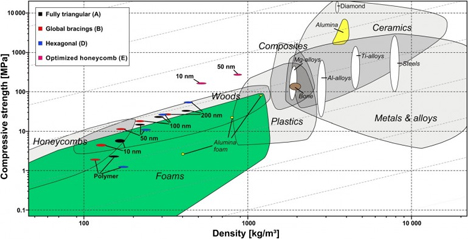
What do bones, wood, and honeycombs have in common? They are all examples of nature’s strong, lightweight building materials. They were also the inspiration behind a German research team’s invention of a low-density, super-strong material. Researchers at Karlsruhe Institute of Technology used laser polymer 3D printing and a ceramic coating to create this microstructured material.

The researchers experimented with different shapes, seeking the one that would allow for the greatest amount of strength with the lightest density. The structures created in the KIT lab were then subjected to strength tests via compression. The honeycomb structure proved to be the strongest. In the words of the team, the materials resemble the framework of a home with beams running in every direction. In the lab, however, the “beams” are microscopic in size.

Super-strong microstructured materials like this ceramic-polymer composite can be used in a variety of applications. Similar materials are already used as insulation or for shock absorption. Because the materials are open-pored, they can also be applied as filters in the chemical industry.




